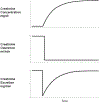The description of a method for accurately estimating creatinine clearance in acute kidney injury
- PMID: 26972743
- PMCID: PMC8101066
- DOI: 10.1016/j.mbs.2016.02.010
The description of a method for accurately estimating creatinine clearance in acute kidney injury
Abstract
Background: Acute kidney injury (AKI) is a common and serious condition encountered in hospitalized patients. The severity of kidney injury is defined by the RIFLE, AKIN, and KDIGO criteria which attempt to establish the degree of renal impairment. The KDIGO guidelines state that the creatinine clearance should be measured whenever possible in AKI and that the serum creatinine concentration and creatinine clearance remain the best clinical indicators of renal function. Neither the RIFLE, AKIN, nor KDIGO criteria estimate actual creatinine clearance. Furthermore there are no accepted methods for accurately estimating creatinine clearance (K) in AKI.
Study design: The present study describes a unique method for estimating K in AKI using urine creatinine excretion over an established time interval (E), an estimate of creatinine production over the same time interval (P), and the estimated static glomerular filtration rate (sGFR), at time zero, utilizing the CKD-EPI formula. Using these variables estimated creatinine clearance (Ke)=E/P * sGFR.
Setting and participants: The method was tested for validity using simulated patients where actual creatinine clearance (Ka) was compared to Ke in several patients, both male and female, and of various ages, body weights, and degrees of renal impairment. These measurements were made at several serum creatinine concentrations in an attempt to determine the accuracy of this method in the non-steady state. In addition E/P and Ke was calculated in hospitalized patients, with AKI, and seen in nephrology consultation by the author. In these patients the accuracy of the method was determined by looking at the following metrics; E/P>1, E/P<1, E=P in an attempt to predict progressive azotemia, recovering azotemia, or stabilization in the level of azotemia respectively. In addition it was determined whether Ke<10 ml/min agreed with Ka and whether patients with AKI on renal replacement therapy could safely terminate dialysis if Ke was greater than 5 ml/min.
Outcomes and results: In the simulated patients there were 96 measurements in six different patients where Ka was compared to Ke. The estimated proportion of Ke within 30% of Ka was 0.907 with 95% exact binomial proportion confidence limits. The predictive accuracy of E/P in the study patients was also reported as a proportion and the associated 95% confidence limits: 0.848 (0.800, 0.896) for E/P<1; 0.939 (0.904, 0.974) for E/P>1 and 0.907 (0.841, 0.973) for 0.9<E/P<1.1. Ke<10 ml/min correlated very well with Ka, while Ke>5 ml/min accurately predicted the ability to terminate renal replacement therapy in AKI.
Limitations: Include the need to measure urine volume accurately. Furthermore the precision of the method requires accurate estimates of sGFR, while a reasonable measure of P is crucial to estimating Ke.
Conclusions: The present study provides the practitioner with a new tool to estimate real time K in AKI with enough precision to predict the severity of the renal injury, including progression, stabilization, or improvement in azotemia. It is the author's belief that this simple method improves on RIFLE, AKIN, and KDIGO for estimating the degree of renal impairment in AKI and allows a more accurate estimate of K in AKI.
Keywords: Acute kidney injury; Creatinine clearance; Creatinine excretion; Creatinine production; Glomerular filtration rate.
Copyright © 2016 The Authors. Published by Elsevier Inc. All rights reserved.
Figures


References
-
- Esson ML, Schrier RW, Diagnosis and treatment of acute tubular necrosis, Ann. Intern. Med 137 (2002) 744. - PubMed
-
- KDIGO, Clinical practice guidelines for AKI, Kidney Int. Suppl 2 (2012) 1–138.
-
- Mehta RL, Chertow GM, Acute renal failure definitions and classifications: time for change? J. Am. Soc. Nephrol 14 (2003) 2178. - PubMed
-
- Ronco C, Kellum JA, Mehta R, Acute dialysis quality initiative (ADQI), Nephrol. Dial. Transplant 16 (2001) 1555. - PubMed
Further reading
-
- Jelliffe R, Creatinine clearance: bedside estimate, Ann. Int. Med 79 (1973) 604–605. - PubMed
Publication types
MeSH terms
Substances
Grants and funding
LinkOut - more resources
Full Text Sources
Other Literature Sources

